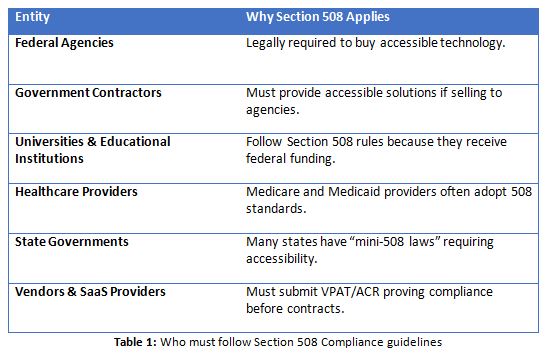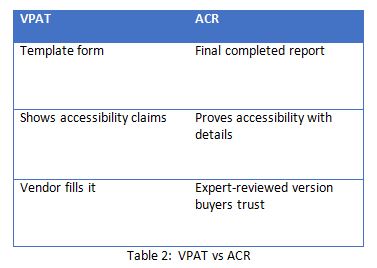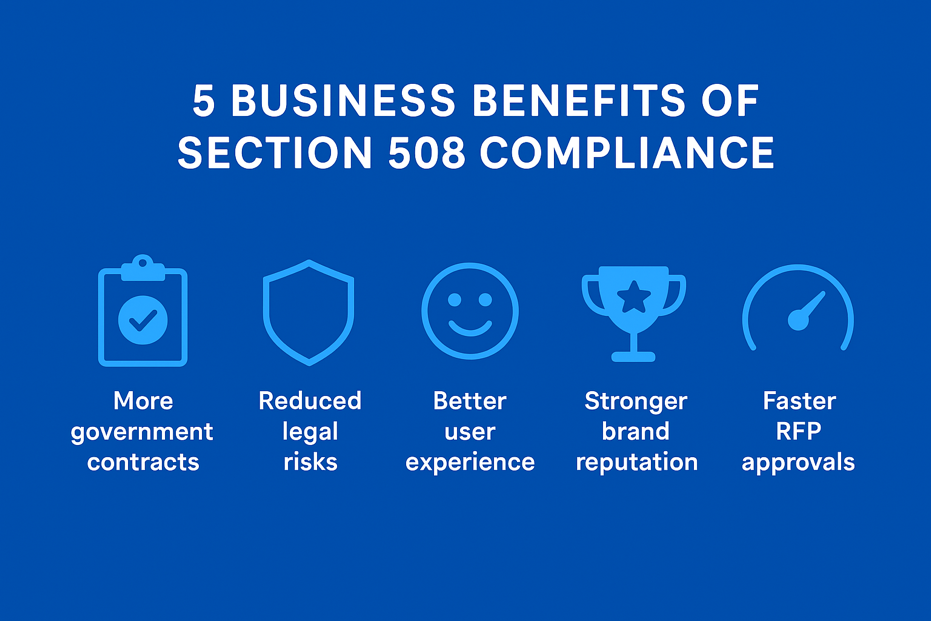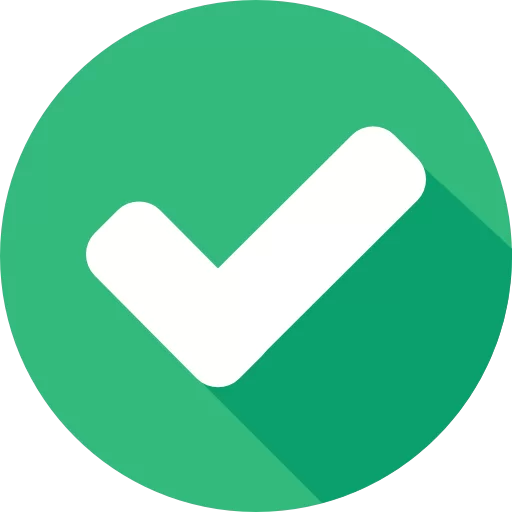
Who Needs to Follow Section 508 Compliance? (Explained for 2025)
If your business plans to sell hardware, software or IT services to the U.S. Government you have probably already heard about Section 508 compliance.
In simple terms, Section 508 is the federal law that makes technology accessible to all users including those with impairments. This law applies to websites and SaaS platforms as well as mobile apps and digital kiosks.
But many vendors lose contracts simply because they fail Section 508 compliance testing. In 2025, it has become a business requirement that can make or break your government deals.
So who exactly needs to follow 508 website compliance?
TL;DR:
- Who must comply with Section 508? All federal agencies, contractors and vendors selling digital products to them.
- Why it matters? Non-compliance leads to lost deals, legal risks and damaged reputation.
- Who else follows it? State governments, universities, healthcare providers and private enterprises often use Section 508 as their standard.
- What is required? Accessibility testing, VPAT documentation and remediation to meet WCAG and Section 508 criteria.
- Fastest way to comply? Choose ADACP for 508 compliance testing, remediation, and accurate Accessibility Conformance Reports (ACRs).
Who Needs to Follow Section 508 Compliance in 2025?
The time has come to invest your resources in compliance testing and remediation. Before you spend, you want to confirm whether you really need it or not. The truth is, compliance can feel confusing because the rules extend beyond just government offices. In the next sections, we discuss who needs to follow Section 508 in 2025, why it matters, and what it means for vendors trying to win contracts.
What is Section 508 Compliance?
Section 508 is part of the Rehabilitation Act of 1973. It was updated in 2018 and now it aligns with WCAG 2.0 AA standards. In 2025, Section 508 references WCAG 2.1 and WCAG 2.2. It covers the following digital accessibility features:
- Screen reader compatibility
- Keyboard navigation
- Color contrast for text and visuals
- Captions for videos
- Accessible forms and interactive elements
In short: 508 web compliance ensures everyone can access your content, no matter whether they are hard of hearing or have vision problems.
Now, when organizations talk about Section 508, another term that often comes up is the VPAT or Voluntary Product Accessibility Template. The VPAT is the document used to report the level of compliance with the rules of Section 508.
At this point, you might be asking what is a VPAT and how does it fit into Section 508 standards. We have explained it in detail in our separate guide [What is a VPAT? (Complete Guide for 2025)].
Who Must Follow Section 508 Compliance?
Here is a simple table showing who needs to comply in 2025:

Do all vendors need to follow Section 508?
You have to follow Section 508 rules if you sell digital products to U.S. federal agencies. Many state agencies, schools and hospitals also expect vendors to meet these rules before signing a contract.
What happens if you don’t comply with Section 508?
Non-compliance with accessibility standards directly impacts your sales cycle.
Your proposal can be rejected during an RFP if you fail to provide Section 508 compliance certification. Buyers may demand endless revisions. You even risk legal complaints for accessibility discrimination. Non-compliance also damages your brand reputation.
Example: A mid-sized technology company lost a federal RFP because their VPAT had errors and their app failed basic keyboard navigation checks. The buyers flagged them for non-compliance and awarded the contract to a competitor.
Fast deals require accurate compliance. Schedule a free consultation with our accessibility experts to learn more about 508 compliance checks and certification.
Is Section 508 Only for Federal Agencies?
This is where most vendors get it wrong.
While Section 508 is federal law, many private enterprises and universities have adopted it as their accessibility benchmark in 2025. For example:
- Universities use Section 508 to ensure all students can access e-learning tools.
- Fortune 500 companies use it for vendor evaluations.
- State governments often pass local accessibility laws modeled after Section 508.
Do private companies have to worry about the Section 508 law?
Private companies are not legally bound to use Section 508 compliance testing tools. However, it has become a general standard for evaluating vendors in 2025. If your product is accessible under Section 508, it improves your chances with both government and enterprise buyers.
How Do You Prove Section 508 Compliance?
Buyers don’t just take your word for it. You need to prove compliance with documentation. Most RFPs in 2025 will not even consider your bid without proper documentation.
Although there is no official 508 compliance certification, the standard proof required is:
- VPAT (Voluntary Product Accessibility Template): The template you fill out.
- ACR (Accessibility Conformance Report): The final, completed report buyers want.

📌 Related Reading: “What is the Difference Between VPAT and ACR?”
How Does Section 508 Compliance Testing Work?
Compliance testing usually includes automated scans for quick accessibility checks and manual testing.
While quick scans are great for flagging obvious issues, they only cover part of the picture. That is why manual testing with assistive technologies is important. With this, you can catch the real-world barriers that automation often misses.
When both methods are combined, you get a complete view of your product’s accessibility and the confidence that buyers and auditors are looking for.
When you ask ADACP to handle 508 compliance testing and remediation, we make sure your websites or PDF documents meet WCAG 2.1 or 2.2.
We manually review pages, forms and interactive elements while also running automated scans to catch common issues. We then prepare a detailed report showing problems and provide clear remediation to ensure full accessibility and compliance.
.webp)
How do you test for Section 508 compliance?
We use a mix of automated scans and hands-on manual testing to ensure compliance. A thorough evaluation should be done by experts who know everything about Section 508 and WCAG accessibility standards.
What Are the Benefits of Section 508 Compliance?
The Federal Acquisition Regulation (FAR) underwent a significant overhaul regarding federal procurement practices as of September 9, 2025. A key aspect of this overhaul is the emphasis on Section 508 requirements. The new rules make it clear that agencies and contractors cannot skip this. They need to follow accessibility standards to avoid legal problems.
Apart from access to government contracts, compliance with accessibility guidelines is linked with reduced legal risks, better user experience for everyone, stronger brand reputation and faster RFP approvals. Read about the benefits of 508 compliance in detail on this blog.

How much does Section 508 compliance cost?
The cost of making your digital products Section 508 compliant can range from a few thousand dollars for a simple website to tens of thousands for a complex app. It might feel expensive but it is a wise investment that pays off. Spend now and avoid much bigger losses later from failed bids.
Conclusion
Who has to follow Section 508 compliance in 2025? Any entity that is serious about accessibility should follow the rules. It definitely includes federal agencies and every vendor selling to the government. Apart from this, 508 rules make things challenging for most universities, healthcare providers and even private enterprises.
If you want to win contracts, compliance becomes essential for you too. Follow the standards and avoid legal issues smartly.
And the easiest way to get it done fast and correctly? Work with experts who handle this every day. Book your free consultation now to achieve 508 website compliance.
If your business plans to sell hardware, software or IT services to the U.S. Government you have probably already heard about Section 508 compliance.
In simple terms, Section 508 is the federal law that makes technology accessible to all users including those with impairments. This law applies to websites and SaaS platforms as well as mobile apps and digital kiosks.
But many vendors lose contracts simply because they fail Section 508 compliance testing. In 2025, it has become a business requirement that can make or break your government deals.
So who exactly needs to follow 508 website compliance?
TL;DR:
- Who must comply with Section 508? All federal agencies, contractors and vendors selling digital products to them.
- Why it matters? Non-compliance leads to lost deals, legal risks and damaged reputation.
- Who else follows it? State governments, universities, healthcare providers and private enterprises often use Section 508 as their standard.
- What is required? Accessibility testing, VPAT documentation and remediation to meet WCAG and Section 508 criteria.
- Fastest way to comply? Choose ADACP for 508 compliance testing, remediation, and accurate Accessibility Conformance Reports (ACRs).
Who Needs to Follow Section 508 Compliance in 2025?
The time has come to invest your resources in compliance testing and remediation. Before you spend, you want to confirm whether you really need it or not. The truth is, compliance can feel confusing because the rules extend beyond just government offices. In the next sections, we discuss who needs to follow Section 508 in 2025, why it matters, and what it means for vendors trying to win contracts.
What is Section 508 Compliance?
Section 508 is part of the Rehabilitation Act of 1973. It was updated in 2018 and now it aligns with WCAG 2.0 AA standards. In 2025, Section 508 references WCAG 2.1 and WCAG 2.2. It covers the following digital accessibility features:
- Screen reader compatibility
- Keyboard navigation
- Color contrast for text and visuals
- Captions for videos
- Accessible forms and interactive elements
In short: 508 web compliance ensures everyone can access your content, no matter whether they are hard of hearing or have vision problems.
Now, when organizations talk about Section 508, another term that often comes up is the VPAT or Voluntary Product Accessibility Template. The VPAT is the document used to report the level of compliance with the rules of Section 508.
At this point, you might be asking what is a VPAT and how does it fit into Section 508 standards. We have explained it in detail in our separate guide [What is a VPAT? (Complete Guide for 2025)].
Who Must Follow Section 508 Compliance?
Here is a simple table showing who needs to comply in 2025:

Do all vendors need to follow Section 508?
You have to follow Section 508 rules if you sell digital products to U.S. federal agencies. Many state agencies, schools and hospitals also expect vendors to meet these rules before signing a contract.
What happens if you don’t comply with Section 508?
Non-compliance with accessibility standards directly impacts your sales cycle.
Your proposal can be rejected during an RFP if you fail to provide Section 508 compliance certification. Buyers may demand endless revisions. You even risk legal complaints for accessibility discrimination. Non-compliance also damages your brand reputation.
Example: A mid-sized technology company lost a federal RFP because their VPAT had errors and their app failed basic keyboard navigation checks. The buyers flagged them for non-compliance and awarded the contract to a competitor.
Fast deals require accurate compliance. Schedule a free consultation with our accessibility experts to learn more about 508 compliance checks and certification.
Is Section 508 Only for Federal Agencies?
This is where most vendors get it wrong.
While Section 508 is federal law, many private enterprises and universities have adopted it as their accessibility benchmark in 2025. For example:
- Universities use Section 508 to ensure all students can access e-learning tools.
- Fortune 500 companies use it for vendor evaluations.
- State governments often pass local accessibility laws modeled after Section 508.
Do private companies have to worry about the Section 508 law?
Private companies are not legally bound to use Section 508 compliance testing tools. However, it has become a general standard for evaluating vendors in 2025. If your product is accessible under Section 508, it improves your chances with both government and enterprise buyers.
How Do You Prove Section 508 Compliance?
Buyers don’t just take your word for it. You need to prove compliance with documentation. Most RFPs in 2025 will not even consider your bid without proper documentation.
Although there is no official 508 compliance certification, the standard proof required is:
- VPAT (Voluntary Product Accessibility Template): The template you fill out.
- ACR (Accessibility Conformance Report): The final, completed report buyers want.

📌 Related Reading: “What is the Difference Between VPAT and ACR?”
How Does Section 508 Compliance Testing Work?
Compliance testing usually includes automated scans for quick accessibility checks and manual testing.
While quick scans are great for flagging obvious issues, they only cover part of the picture. That is why manual testing with assistive technologies is important. With this, you can catch the real-world barriers that automation often misses.
When both methods are combined, you get a complete view of your product’s accessibility and the confidence that buyers and auditors are looking for.
When you ask ADACP to handle 508 compliance testing and remediation, we make sure your websites or PDF documents meet WCAG 2.1 or 2.2.
We manually review pages, forms and interactive elements while also running automated scans to catch common issues. We then prepare a detailed report showing problems and provide clear remediation to ensure full accessibility and compliance.
.webp)
How do you test for Section 508 compliance?
We use a mix of automated scans and hands-on manual testing to ensure compliance. A thorough evaluation should be done by experts who know everything about Section 508 and WCAG accessibility standards.
What Are the Benefits of Section 508 Compliance?
The Federal Acquisition Regulation (FAR) underwent a significant overhaul regarding federal procurement practices as of September 9, 2025. A key aspect of this overhaul is the emphasis on Section 508 requirements. The new rules make it clear that agencies and contractors cannot skip this. They need to follow accessibility standards to avoid legal problems.
Apart from access to government contracts, compliance with accessibility guidelines is linked with reduced legal risks, better user experience for everyone, stronger brand reputation and faster RFP approvals. Read about the benefits of 508 compliance in detail on this blog.

How much does Section 508 compliance cost?
The cost of making your digital products Section 508 compliant can range from a few thousand dollars for a simple website to tens of thousands for a complex app. It might feel expensive but it is a wise investment that pays off. Spend now and avoid much bigger losses later from failed bids.
Conclusion
Who has to follow Section 508 compliance in 2025? Any entity that is serious about accessibility should follow the rules. It definitely includes federal agencies and every vendor selling to the government. Apart from this, 508 rules make things challenging for most universities, healthcare providers and even private enterprises.
If you want to win contracts, compliance becomes essential for you too. Follow the standards and avoid legal issues smartly.
And the easiest way to get it done fast and correctly? Work with experts who handle this every day. Book your free consultation now to achieve 508 website compliance.

We will contact you shortly.





.svg)
.svg)
.svg)
.webp)























.svg)

.svg)